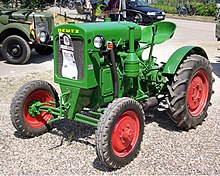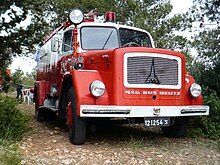Deutz AG
 | |
| Company type | Aktiengesellschaft |
|---|---|
| FWB:DEZ | |
| Industry | Mechanical engineering |
| Founded | March 31, 1864 |
| Founder | Nicolaus Otto Eugen Langen |
| Headquarters | Cologne,Germany |
Area served | Worldwide |
Key people | Sebastian Schulte(CEO,CFO) Dietmar Voggenreiter(Chairmanof thesupervisory board) |
| Products | Diesel enginesand engine components foragricultural machinery,marine propulsion,automobilesandconstruction equipment |
| Revenue | €2,104.8 million (2023) |
| €81.9 million (2023) | |
| Total assets | €1.213 billion (2017) |
| Total equity | €743.2 million (2023) |
Number of employees | 5,284 (2023) |
| Website | deutz |
Deutz AGis a Germaninternal combustion enginemanufacturer, based inPorz, Cologne,Germany.[1]
History
[edit]

(Downpatrick & Co Down Railway)



The company was founded byNicolaus Otto,the inventor of thefour-strokeinternal combustion engine, and his partnerEugen Langenon 31 March 1864, asN. A. Otto & Cie,[2]later renamed to Gasmotoren-Fabrik Deutz after moving operations in 1869,[3]from Cologne toDeutz,located on the opposite side of theRhine.
In the early years, Otto and Langen were interested only in producingstationary engines,not automobiles.[4]The technical director,Gottlieb Daimler,was eager to produce automobiles. In the middle of the 1870s, it was suggested that he transfer to the company'sSt. Petersburgfactory to reduce his influence. He resigned, takingWilhelm Maybachwith him.[4]Deutz also produced agricultural machines such asCombine harvestersandTractors,as well as Commercial Vehicles such asTrucksandBuses.
In 1884,Edouard Sarazin,a Belgian patentsLawyerand Pioneer of automotive engineering, represented 'Gasmotorenfabrik Otto & Langen' (Deutz AG) and acquired the license to build Deutz engines inFrance,which he duly contracted toPerin, Panhard & Cie(laterPanhard et Levassor) inParis.Around 1886/1887, he similarly acquired licenses to build Daimler engines. His untimely death in 1887, left his widowLouiseto develop the business relationships and complete the partnership negotiations.[5][6]: p.11 : p.14 [7]: p.101 [8]
Famous people who have worked for Deutz include Eugen Langen, Nicolaus Otto, Gottlieb Daimler (from 1872 until 1880), Wilhelm Maybach (from 1872 until 1880),Prosper L'Orange(from 1904 until October 1908),Ettore Bugatti(in 1907), andRobert Bosch.
DuringWorld War II,the company was ordered to produce artillery and operated under the nameKlöckner Humboldt Deutz AG(KHD).[9]In 1942, KHD was declared a war model company by the National Socialist German Workers' Front for its "services to the defense economy". In this context, the company relied heavily on the use of forced laborers. In the 1942/1943 financial year, 2127 people, mainly from Western Europe, were forced to work at KHD. In some cases, up to 40 percent of the workers in the plants were forced laborers.[10]The factory was almost destroyed by an air raid on the night of the 3rd and 4th of July 1943 (→Bombing of Cologne in WW II).[11]
From 1892 to 1970, Deutz built locomotives in the power range from 4 HP to 2000 HP; until 1927, with gasoline engines, and from 1927, increasingly with diesel engine drive.
Commercial vehicles powered by Deutz engines were popular from 1960 to 1980. Fire engines built byMagirusinUlm,Southern Germany,used an M-shaped logo, with the steeple of the world's tallest church, theUlm Minster,in its center. After the Magirus-Deutz merger, the company continued to use this logo even though the twin towers of theCologne Cathedralcan be seen from the company headquarters.
Deutz's head office is in the Porz district ofCologneand, as of 2004, was manufacturingliquid and air-cooleddiesel engines.The larger engines in the Deutz range were manufactured inMannheimat a production facility that once belonged to Süddeutsche Bremsen-AG as MWM-Diesel. Deutz also has production facilities in other countries, including Spain, and a joint venture production facility in China. After Deutz took over, the plant specialized in marine engines. This facility now produces engines for marine and power generation, which can run on either fuel oils or fuel gases (includinglandfill gas). In 1995 Deutz sold its agricultural machinery division –Deutz-Fahr– to the Italian companySAME,formingSAME Deutz-Fahr.
In February 2022, CEO Frank Hiller was dismissed and replaced by the supervisory board. Sebastian Schulte replaced him as the interim CEO & CFO. The Chairman of the Supervisory Board, Bernd Bohr, resigned. His successor was Dietmar Voggenreiter.[12]
Engines
[edit]This sectioncontains content that is written likean advertisement.(August 2020) |
Deutz engines are available in the power range of 5 to 500 kW, with air, oil or water cooling and with life expectancy of 20,000 to 30,000 running hours TBO (Time Between Overhauling) on rebuilt and brand-new units.
Parts and services are available worldwide. A network of distributors in theUnited StatesandCanadawas established.
Deutz-poweredair-cooledengine are well-suited for many applications since they cannot freeze or boil over during normal operation.
Deutz also manufactures oil-cooled engines. These can provide the same power as other engine designs, but in a smaller package, since they do not require the additional space to house a radiator.[citation needed]Deutz also makes engines with a tandem oil cooler/radiator configuration; these also do not require antifreeze or coolant agents.
Deutz also sells a line of economic liquid-cooled engines.
In 2007, the "Deutz Power Systems" division was sold to3i,and Deutz AG now concentrates on producing and selling compact engines under the Deutz brand only. They focus on manufacturing engines only for the customer, without competing for the entire piece of finished machinery.
On October 1 2008, the formerDeutz Power Systemsdivision received a new, old, nameMWM (Motoren Werke Mannheim AG).Karl Benz established the company in 1871. After splitting the engine business from Benz AG, it became Motoren-Werke Mannheim AG. Klöckner-Humboldt-Deutz AG took over in 1985, later becoming Deutz AG. After spinning off Deutz Power Systems, the company has made a full circle back to MWM.[13]
In 2012,SAME Deutz-Fahrsold 22 million shares, the majority of its holding in Deutz AG, to Volvo, making of it the largest shareholder at just over 25%. SAME Deutz-Fahr retained 8.4% equity in the company.[14]
In 2017, Deutz acquired Torqeedo[15]GmbH, specialist for integrated electric and hybrid drives for boats. Volvo sold all of its ownership stakes in Deutz in the same year.[16]
Former business
[edit]Locomotive and wagon construction (1892-1970)
[edit]Until the 1950s, only small locomotives (e.g. light rail locomotives) were produced. After the interest group formed in 1953 with the United Westdeutsche Waggonfabriken AG (Westwaggon) and their final takeover in 1959, KHD was also able to build largebogiediesel locomotives.
- Class V60 of the Deutsche Bundesbahn from 1957
- Class V100 of the Deutsche Bundesbahn from 1961
- Class V160 of the Deutsche Bundesbahn from 1966
- Class V90 of the Deutsche Bundesbahn from 1967
Other types of construction for industrial and private railways were also produced between 1959 and 1970, including:
- Type KHD PMZ122R from 1929
- Types KHD A4M 220 R / 420 R from 1934
- Type KHD A6M 324 R from 1934
- Type KHD A8M 324 R type C from 1938
- Type KHD A2L 514 R from 1952
- Type KHD A8L 614 R from 1953
- Type KHD T8M 625 R 1956
- Type KHD DG 2000 BBM 1956
- Type KHD DG 2000 CCE 1957
- Type KHD KS 55 B from 1958
- Type KHD MS 800 D 1959
- Type KHD DG 1000 BBM from 1959
- Type KHD DG 1200 BBM from 1960
- Type KHD DG 1600 CCM from 1959
- Type KHD DG 2000 CCM from 1963
- Type KHD DG 1500 CCM 1970
Notes
[edit]- ^"Handelsblatt".handelsblatt.Retrieved2024-07-05.
- ^"Nicolaus August Otto and the Four-Stroke Engine | Museumsblog".stories.technik-museum.de.2022-12-05.Retrieved2024-07-05.
- ^"Gasmotorenfabrik Köln Deutz".rheinische-industriekultur.Retrieved2024-07-05.
- ^abGeorgano, G.N.Cars: Early and Vintage, 1886-1930.(London: Grange-Universal, 1985)
- ^Motor Museum in Miniature - Louise Sarazin
- ^James M. Laux:In First Gear. The French automobile industry to 1914.McGill-Queen’s University Press, Montreal 1976, ISBN 0-7735-0264-5.
- ^Reinhard Seiffert:The era of Gottlieb Daimler(Die Ära Gottlieb Daimlers).
- ^"Daimler | Leaders and Personalities".Louise and Edouard Sarazin.Archived fromthe originalon 9 November 2013.Retrieved9 November2013.
- ^Rieke Klindworth (1997), "Zwangsarbeit bei der Klöckner-Humboldt-Deutz AG (1940–1945)",Geschichte in Köln,vol. 42, no. 1, pp. 87–118,doi:10.7788/gik.1997.42.1.87,S2CID179405990
- ^Klindworth, Rieke (1997). "Zwangsarbeit bei der Klöckner-Humboldt-Deutz AG (1940–1945)".Geschichte in Köln.42:87–118.doi:10.7788/gik.1997.42.1.87.S2CID179405990.
- ^"Geschichtswerkstatt Köln-Kalk » Kriege, Zerstörung und Wiederaufbau".Archived fromthe originalon 2017-12-22.Retrieved2017-12-19.
- ^Müller-Arnold, Benedikt."Deutz und die Frauenquote: Wie töricht sich Männer anstellen können".Süddeutsche.de(in German).Retrieved2022-07-19.
- ^"Presse".Archived fromthe originalon 2008-11-02.Retrieved2008-11-03.
- ^"DEUTZ AG - PRESS - Press Container - Volvo increases stake in DEUTZ to 25% plus 1 share".Archived fromthe originalon 2012-11-24.Retrieved2012-07-24.
- ^"Deutz acquired Torqeedo".
- ^"AB Volvo has sold its investment in DEUTZ AG".deutz.Retrieved7 July2021.
External links
[edit]- Diesel engine manufacturers
- Engine manufacturers of Germany
- Manufacturing companies based in Cologne
- Companies listed on the Frankfurt Stock Exchange
- German brands
- Manufacturing companies established in 1864
- German companies established in 1864
- Companies formerly in the MDAX
- Marine engine manufacturers
- Gas engine manufacturers
- Agriculture companies of Germany
- Motor vehicle engine manufacturers
